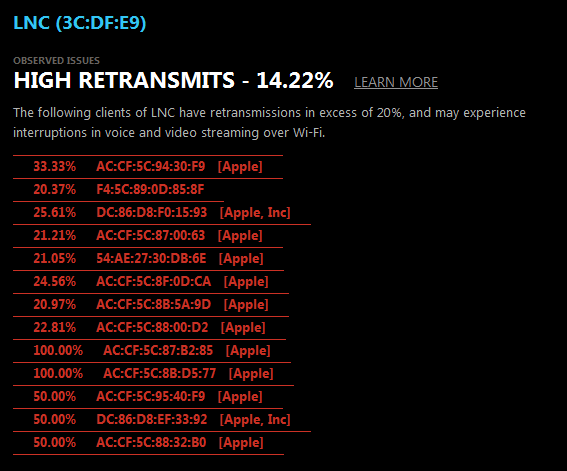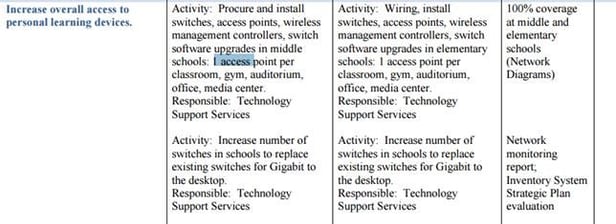The title and content of this article will probably be largely dismissed by the salespeople and resellers who are making generous margins on implementing what I am writing against.
I wrote this blog because of what I see in my job and because I feel it is wrong and wasteful to implement these irresponsible WiFi designs, if you can even call them designs at all.
It doesn't take a talented RF engineer to count up the number of classrooms in a hallway and quote an access point (AP) for each.
My livelihood as a solutions provider depends on selling our solutions and making revenue for the company. I feel that in the long run, opting for a correct WiFi design trumps the quick buck.
So, to clarify my position on this topic and help you avoid this disastrous WiFi design strategy, let me take you through the numbers and explain why deploying one access point per classroom doesn't make any sense.
Before we begin
First let me set some initial understanding of the environment that I am talking about.
What I am referring to is a K-12 environment in a building with typical drywall and stud walls or at most cinderblock or brick walls that have minimal impact on RF propagation.
I am not talking about poured, 18 to 24 inch thick concrete walls with reinforced rebar and wire mesh applied for application of tiling or other fascia coverings which creates absolute RF barriers.
I am simply referring to what probably 85 – 90% of the K-12 buildings have used in the past 40 to 50 years for interior wall construction. These environments are not RF challenging and do not require the RF over-saturation that a “One AP per Classroom” design imposes.
Now that we've set-up the environment, let's take a look at the specific points behind why I don't agree with this awful WiFi design approach.
1. Enterprise Grade APs are Robust
Most Enterprise grade APs are capable of supporting 40 – 50 users without breaking a sweat. Since most classrooms seat 30 students, a good AP can support three classrooms.
If you're questioning my math for this example, let me explain.
Three classrooms with 30 students each would net us a total of 90 students needing to use a single AP. However, in reality we don’t see all 90 students accessing the AP at the same time.
In the real world, we see about 50% associated or connected which is 45 students, and then only about 40% actively using bandwidth or through putting on the system which is 36 students. Now can you see how a single AP can support three classrooms?
2. The Quality of your WiFi Design Makes a Huge Difference
If a WiFi design is produced properly and correctly, a single AP can provide an optimal RSSI level of -65dB at the client using a power setting of 12-15dB on the AP, covering three or maybe even four classrooms (depending on the room size and wall materials).
This is more than adequate to support a 1:1 initiative in the classroom using iPads, Chromebooks or laptops.
Deploying an AP in all three or four classrooms only increases costs unnecessarily, including: cabling, installation, support, switch ports, power, cooling for all the switching, etc.
3. Too Much Interference
The implementation of a “One AP per Classroom” solution negatively affects the WLAN by inducing very high levels of co-channel and adjacent channel interference or contention.
If left unchecked these factors can bring a WLAN to an absolute crawl and render it unusable.
Proper design of a WLAN will take these factors into account and eliminate them or mitigate them to a point where a high level of performance can be delivered.
Here is what you don’t want to see from your school WLAN.

Retry rates this high essentially means up to 100% of the time for some of the wireless clients they are resending what they have already sent. This slows WiFi performance to a halt in these instances.
4. It Always Comes Down to Cost
A mid-level AP suitable for a classroom from an Enterprise WLAN manufacturer will run about $700. A higher end AP with more resources; better CPU, more RAM and more flash will run about $1000.
If a provider quotes a “One AP per Classroom” solution using a mid-level AP the cost for four classrooms is going to be $2800.
If a proper design is done and a single AP for four classrooms is proposed the cost is going to be $1000. This is just the cost of the AP hardware and does not take into account the potential cost savings for cabling, switches, power, cooling and labor.
Closing Thoughts
I am running into this type of implementation more and more and it is because of improper guidance being provided by organizations who have not consulted with trained, certified, experienced WLAN engineers who adhere to sound design and implementation practices.
To me this practice is no different than taking your accountants guidance on how to design and build a home. It makes no sense and is a waste of money for institutions and taxpayers alike.
Here are some examples where schools are instructed on what is appropriate for support of 1:1 programs:
The excerpt below was referenced from MCNC:

This example was referenced from the technology plan for Gaston County Schools via Carolina Department of Instruction (Public Schools of North Carolina).

Here is another example from Charlotte-Mecklenburg Schools, where a school district is claiming their WiFi is now good with 1.5 access points per classroom. I have personally seen and analyzed this environment and it is terrible WiFi.

These examples go on and on and are just further proof of the perpetuated fallacy that “One AP per Classroom” is a valid universal solution.
In a follow-up blog post, I will outline some recommendations on how you can address a “One AP per Classroom” solution that you may have been sold. I will give some guidance on what can be done to make it work the best it can for the situation it presents.
For a more in-depth and thorough analysis on this topic, that goes beyond our quick overview, check out this excellent white paper from Wireless LAN Professionals:
If you have any questions or would like to discuss an upcoming project, please contact us here.





